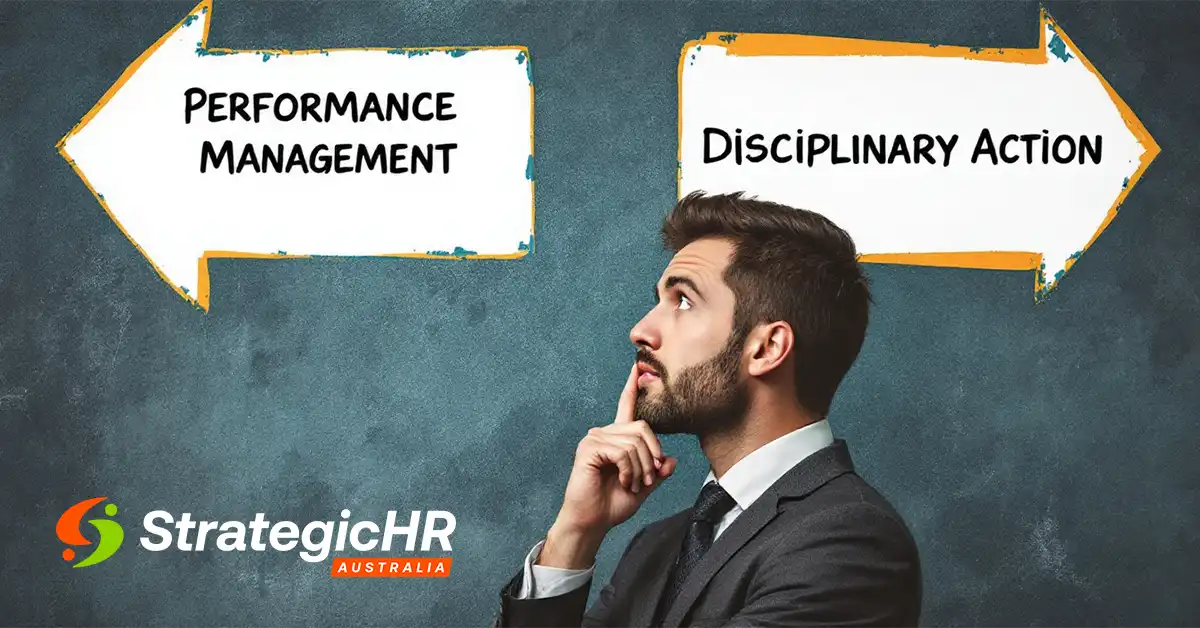In the ever-changing world of work, understanding the difference between performance management and disciplinary action is vital for both business owners and employees. Think of it as managing a high-performing team-get it right, and everyone thrives; get it wrong, and you risk a breakdown in communication and productivity. Let’s explore why this distinction matters and how to address each situation effectively.
Performance Management: Building Potential
Performance management is all about helping employees reach their potential. It’s a proactive process aimed at improving skills, aligning individual goals with business objectives, and boosting workplace efficiency. Key elements include:
-
- Clear Expectations: Employees perform best when they understand their roles and responsibilities.
-
- Regular Feedback: Constructive feedback ensures employees stay on track and grow in their roles.
-
- Training and Development: Offering learning opportunities keeps employees engaged and helps them adapt to new challenges.
When done right, performance management fosters a positive work environment, driving both individual and company success.
Disciplinary Action: Addressing Misconduct
On the flip side, disciplinary action is a reactive measure used to address misconduct or behaviour that goes against workplace policies. Examples include:
-
- Failure to Meet Deadlines: Consistently missing agreed-upon timelines or failing to deliver work on schedule.
-
- Insubordination: Refusing to follow reasonable workplace instructions or policies.
-
- Serious Misconduct: Acts such as theft, bullying, or harassment that require immediate attention.
Disciplinary action aims to correct behaviour, uphold workplace standards, and maintain fairness across the board. Following the Fair Work Regulations, employers must ensure any disciplinary process is transparent, documented, and conducted with procedural fairness.
Why the Distinction Matters
It’s crucial to recognise whether an issue stems from underperformance or misconduct. Mislabelling an issue can lead to ineffective responses—training won’t fix deliberate policy breaches, just as punitive measures won’t resolve skill gaps.
For Business Owners: Missteps in handling these matters could result in legal risks, hefty financial repercussions, and reputational damage. Proper processes safeguard your business and foster employee loyalty.
For Employees: Understanding these distinctions helps you address concerns effectively and advocate for fair treatment.
When Performance and Conduct Overlap
Sometimes, performance and conduct issues intertwine. For example, an employee struggling with task deadlines (performance) might also refuse to participate in improvement plans (conduct). In such cases, start with performance management, and if the issue persists, escalate to disciplinary measures. Remember, skipping performance management and directly taking disciplinary action without adhering to procedural fairness can backfire, resulting in adverse outcomes under the Fair Work Act 2009 (Cth).
Practical Steps for Success
Here’s how to handle these challenges effectively:
-
- Set Clear Policies: Ensure all employees are aware of workplace expectations, performance standards, and the consequences of non-compliance.
-
- Set the tone from the jump- include policies and procedures in employee handbooks and induction programs.
-
- Set Clear Policies: Ensure all employees are aware of workplace expectations, performance standards, and the consequences of non-compliance.
-
- Document Everything: Keep detailed records of discussions, training sessions, performance reviews, and any disciplinary actions.
-
- Documentation helps demonstrate procedural fairness and protects both the employee and employer against disputes.
-
- Document Everything: Keep detailed records of discussions, training sessions, performance reviews, and any disciplinary actions.
-
- Communicate Openly: Establish a culture of open communication.
-
- Regular one-on-one meetings between managers and employees create opportunities to address performance issues early and collaboratively.
-
- Communicate Openly: Establish a culture of open communication.
-
- Apply Consistent Standards: Treat similar situations in the same way to maintain fairness and credibility.
-
- Inconsistencies can lead to claims of bias or discrimination.
-
- Apply Consistent Standards: Treat similar situations in the same way to maintain fairness and credibility.
-
- Manage Managers: Provide managers with regular training on handling performance management and disciplinary processes.
-
- Equip them with the skills to identify issues accurately, conduct fair investigations, and follow correct procedures.
-
- Manage Managers: Provide managers with regular training on handling performance management and disciplinary processes.
- Seek Guidance from Expert HR Advisors: When in doubt, consult a HR professional to ensure your approach complies with legal standards and best practices. For professional HR advice, you can reach out to Strategic HR Australia.
Final Thoughts
Whether you’re a business owner navigating tricky HR situations or an employee seeking clarity on your workplace rights, understanding the difference between performance management and disciplinary action is essential. By addressing each issue appropriately, you can foster a more effective, supportive, and harmonious workplace. Remember: a well-managed team is a thriving team!







